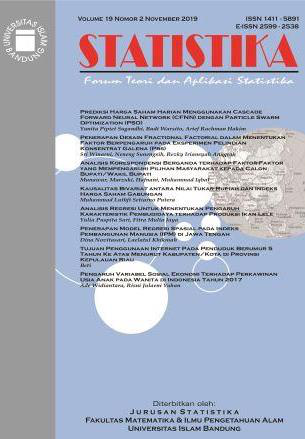Analisis Faktor-Faktor yang Mempengaruhi Keputusan Pembelian Ulang dan Kepuasan Konsumen pada Produk Garam di PT. UCI Gresik Jawa Timur Indonesia
DOI:
https://doi.org/10.29313/statistika.v22i1.503Keywords:
Marketing Mix, Keputusan Pembelian Ulang, Kepuasan Konsumen, SEM PLSAbstract
ABSTRAK
Persepsi konsumen terhadap tuntutan kebutuhan garam sangat beragam. Terdapat beberapa ariab yang menjadi pertimbangkan konsumen sebelum menggunakan produk garam, factor-faktor tersebut diantaranya adalah harga, kualitas, distribusi, dan promosi. Pada sisi tertentu, konsumen akan merasa puas jika layanan PT. UNIChem Candi Indonesia unit Gresik Jawa Timur (PT UCI Gresik Jatim) melebihi harapan konsumen. Faktor-faktor yang mempengaruhi keputusan pembelian ulang dan kepuasan konsumen terhadap produk garam PT UCI Gresik Jawa Timur diungkapkan secara komprehensif dengan persamaan ariablel berbasis komponen varian, Structural Equation Modeling-Partial Least Square (SEM-PLS). Dengan sampel sebanyak 65 responden, hasil analisis menunjukkan bahwa terdapat beberapa indikator yang tidak valid yaitu pada indikator Hr2, Kp2 dan B2, kemudian setelah indikator tersebut tidak digunakan didapatkan nilai R2 yang moderat yaitu 80,4% untuk variabel kepuasan konsumen dan nilai R2 yang lemah 11,5% pada variabel keputusan pembelian ulang, serta nilai Q2 sebesar 0,827 yang menjelaskan bahwa pemodelan kepuasan konsumen memiliki prediksi yang relevan. Kemudian pada pengujian hipotesis didapatkan hasil bahwa semua variabel laten dipengaruhi secara positif oleh masing-masing indikatornya, pada pengujian struktural didapatkan variabel distribusi memiliki pengaruh yang tidak signifikan terhadap model kepuasan konsumen dengan nilai 0,153 sedangkan untuk variabel lainya memiliki pengaruh yang signifikan terhadap kepuasan konsumen, selain itu kepuasan konsumen juga memiliki pengaruh yang positif dan signifikan terhadap keputusan pembelian ulang sebesar 0,339.
ABSTRACT
Consumer perceptions of the need for salt are very diverse. There are several variables that consumers consider before using salt products, these factors include price, quality, distribution, and promotion. On a certain side, consumers will feel satisfied if UNIChem Candi Indonesia company unit Gresik East Java (UCI Gresik East Java company) exceeded consumer expectations. Factors that influence repurchase decisions and consumer satisfaction with UCI Gresik East Java's salt products are comprehensively disclosed by the component variant-based variable equation, Structural Equation Modeling-Partial Least Square (SEM-PLS). With a sample of 65 respondents, the results of the analysis show that there are several invalid indicators, namely the Hr2, Kp2 and B2 indicators, then after these
indicators are not used, a moderate R2 value is obtained, namely 80.4% for the variable consumer satisfaction and a weak R2 value 11.5% on the repurchase decision variable, and a Q2 value of 0.827 which explains that the customer satisfaction model has relevant predictions. Then in testing the hypothesis it was found that all latent variables were positively influenced by each indicator, in structural testing it was found that the distribution variable had an insignificant effect on the consumer satisfaction model with a value of 0.153 while for other variables it had a significant influence on customer satisfaction, apart from In addition, consumer satisfaction also has a positive and significant influence on repurchasing decisions of 0.339.
References
Chin, W.W., (1998), The partial least square approach for structural equation modeling. In G. A. Macroulides (Ed). Modern methods for business research. London Lawrence Erlbaum Associates. hlm295-236.
Devi, B.C., Hoyyi, A.,& Mukid, M.A., (2015), Analisa Faktor-faktor yang Mempengaruhi Keputusan Pembelian dan Kepuasan Konsumen pada Layanan Internet Speedy di Kota Semarang Menggunakan Partial Least Square, Jurnal Gausian, Vol.4, No.3, 485-495.
Ghozali, I., dan Latan, (2012), Partial Least Square Konsep, Tehnik dan Aplikasi Menggunakan Program Smart PLS 2.0 M3. Semarang: UNDIP.
Hair Jr, J.F., Sarstedt, M., Hopkins, L., & Kuppelwieser, V. G., (2013), Partial least squares structural equation modeling (PLSSEM) An emerging tool in business research. European Business Review.
Henseler, J., Ringle, C.M., dan Sinkovics, R.R., (2009), The Use Of Partial Least Squares Path Modeling In International Marketing, Advances in International Marketing, Volume 20, 277–319.
Wibowo A., (2007), Pengukuran indeks kepuasan pelanggan dengan pendekatan structural equation modeling. [skripsi]. FMIPA, UGM.
Walpole, R.E. (1982). Pengantar Statistika. Terjemahan oleh Bambang Sumantri. (1993). Jakarta: Gramedia.
















